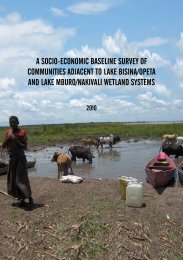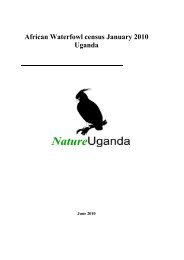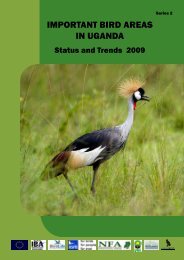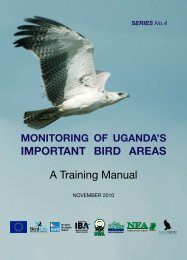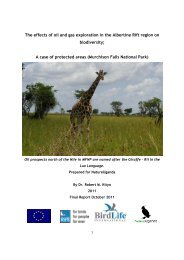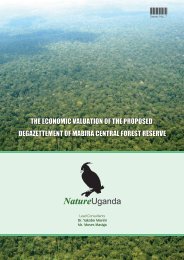A Ecological Baseline Surveys Of: - Lake Bisina - Nature Uganda
A Ecological Baseline Surveys Of: - Lake Bisina - Nature Uganda
A Ecological Baseline Surveys Of: - Lake Bisina - Nature Uganda
Create successful ePaper yourself
Turn your PDF publications into a flip-book with our unique Google optimized e-Paper software.
4.1.3 Plant diversity<br />
Plants offer potential advantages over other taxa as biodiversity indicators because they are<br />
the primary producers. Their abundance and diversity is likely to influence the species richness<br />
belonging to higher trophic levels (Kent et al. 1996). An inventory of all plant species was carried<br />
out in the study site.<br />
4.1.4 Physical and ecological features<br />
This wetland system is an Acacia-Echinochloa-Cyperus wetland associated with grasses and<br />
scattered thickets of Allophylus abyssinica and other forest colonisers. It has been highly modified<br />
by human activities through farming and cutting of the natural vegetation.<br />
4.1.5 Land tenure and status<br />
The site lies partly within a gazetted National Park and communal land. The main activities are<br />
subsistance farming and fishing.<br />
4.1.6 Study objectives and methods.<br />
4.1.6.1 The specific objectives of this vegetation survey were to:<br />
i. Produce guiding methods of wetland vegetation assessment for the two systems.<br />
ii. Establish baseline information on wetland vegetation richness or diversity.<br />
iii. Identify indicator species that may be used as eco-system vegetation monitoring.<br />
iv. Take appropriate GPS coordinates of surveyed areas (including for secondary data)<br />
v. Make field observations and descriptions as supportive information to the report.<br />
vi. Explore existing surveys report and use as supporting data where appropriate.<br />
vii. Produce a comprehensive report on the wetland vegetation diversity (Checklist).<br />
4.1.6.2 Methods<br />
The following general approaches were adopted as a basis for assessing the flora.<br />
Sampling: Sampling points were selected in such a way that a maximum number of strata were<br />
represented at a given site as a way of minimising time spent on movement to sample different<br />
strata. Vegetation strata (layers) were identified and for each layer the percentage cover for the<br />
species was estimated visually and recorded. Opportunistic sampling was also applied especially<br />
for the micro habitats registered in the study area.<br />
Layer code: The layer codes were by height not habitat. Tree layers were ranging between 3 - >5<br />
m high. In this class for example, papyrus which is a sedge, if it was >3m, was recorded here and<br />
likewise, a tree seedling that was



